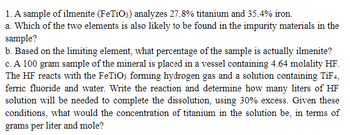
Chemistry for Engineering Students
4th Edition
ISBN: 9781337398909
Author: Lawrence S. Brown, Tom Holme
Publisher: Cengage Learning
expand_more
expand_more
format_list_bulleted
Question

Transcribed Image Text:1. A sample of ilmenite (FeTiO3) analyzes 27.8% titanium and 35.4% iron.
a. Which of the two elements is also likely to be found in the impurity materials in the
sample?
b. Based on the limiting element, what percentage of the sample is actually ilmenite?
c. A 100 gram sample of the mineral is placed in a vessel containing 4.64 molality HF.
The HF reacts with the FeTiO3 forming hydrogen gas and a solution containing TiF4,
ferric fluoride and water. Write the reaction and determine how many liters of HF
solution will be needed to complete the dissolution, using 30% excess. Given these
conditions, what would the concentration of titanium in the solution be, in terms of
grams per liter and mole?
Expert Solution
This question has been solved!
Explore an expertly crafted, step-by-step solution for a thorough understanding of key concepts.
Step by stepSolved in 2 steps

Knowledge Booster
Similar questions
- What possible uses exist for the natural gas liquids that are removed from natural gas during its processing?arrow_forwardAcetylene can be made by reacting calcium carbide with water. CaC2(s) + 2 H2O() C2H2(g) + Ca(OH)2(aq) Assume that you place 2.65 g CaC2 in excess water and collect the acetylene over water. The volume of the acetylene and water vapor is 795 mL at 25.0 C and a barometric pressure of 735.2 mmHg. Calculate the percent yield of acetylene. The vapor pressure of water at 25 C is 23.8 mmHg.arrow_forwardWhat is the microscopic explanation for the macroscopic behaviour illustrated in Figure 11.15?arrow_forward
- The mercury content of a stream was believed to be above the minimum considered safe —1 part per billion (ppb) by weight. An analysis indicated that the concentration was 0.68 parts per billion. What quantity of mercury in grams was present in 15.0 L of the water, the density of which is 0.998 g/ml? ( 1ppbHg=1ngHg1gwater)arrow_forwardUse the web to look up information on nanotubes. Distinguish between single-walled and double-walled nanotubes.arrow_forwardQ: quartz is feldspathic. a. True. b. False.arrow_forward
- Minerals that generally form from the evaporation of a water-based solution belong to which chemical group?arrow_forward7. It is not possible to pack spheres together without leaving some void spaces between the spheres. Packing efficiency is the fraction of space in a crystal that is actually occupied by atoms. Determine the packing efficiency of a face- centered cubic metal as shown in a figure below. 4r- - 45° 8. What determines which species in a solid solution is the solute and which is the solvent? Explain the 24-karat Gold preparation. Au Ag Substitutional alloy 14karat geld Interstitial alloy Sael 9. The unit cell of a binary compound of copper and oxygen is shown here. Given this image and the ionic radii (a) determine the empirical formula of this compound, Cu* = 0.74 Å and ro = 1.26 A (b) determine the coordination numbers of copper and oxygen, (c) estimate the length of the edge of the cubic unit cell, and (d) estimate the density of the compound.arrow_forwardCrystal Structure Direction: Answer the following questions. Show your solution. 1. Below are listed the atomic weight, density, and atomic radius for three hypothetical alloys. For each determine whether its crystal structure is FCC, BCC, or simple cubic and then justify your determination. Atomic Weight (g/mol) Density (g/cm") Atomic Radius (пт) Alloy A B 43.1 184.4 6.40 12.30 0.122 0.146 0.137 91.6 9.60arrow_forward
- Draw the following crystallographic planes in the unit cells provided below a. (211) b. (301)c.(110) x x xarrow_forward6. Polonium crystallizes in the simple cubic lattice. What is the coordination number for Po?arrow_forwardWhy are there no more than 7 crystal systems ? What are quasicrystals ?arrow_forward
arrow_back_ios
SEE MORE QUESTIONS
arrow_forward_ios
Recommended textbooks for you
 Chemistry for Engineering StudentsChemistryISBN:9781337398909Author:Lawrence S. Brown, Tom HolmePublisher:Cengage Learning
Chemistry for Engineering StudentsChemistryISBN:9781337398909Author:Lawrence S. Brown, Tom HolmePublisher:Cengage Learning ChemistryChemistryISBN:9781305957404Author:Steven S. Zumdahl, Susan A. Zumdahl, Donald J. DeCostePublisher:Cengage Learning
ChemistryChemistryISBN:9781305957404Author:Steven S. Zumdahl, Susan A. Zumdahl, Donald J. DeCostePublisher:Cengage Learning Chemistry: An Atoms First ApproachChemistryISBN:9781305079243Author:Steven S. Zumdahl, Susan A. ZumdahlPublisher:Cengage Learning
Chemistry: An Atoms First ApproachChemistryISBN:9781305079243Author:Steven S. Zumdahl, Susan A. ZumdahlPublisher:Cengage Learning
 Introductory Chemistry: A FoundationChemistryISBN:9781337399425Author:Steven S. Zumdahl, Donald J. DeCostePublisher:Cengage Learning
Introductory Chemistry: A FoundationChemistryISBN:9781337399425Author:Steven S. Zumdahl, Donald J. DeCostePublisher:Cengage Learning

Chemistry for Engineering Students
Chemistry
ISBN:9781337398909
Author:Lawrence S. Brown, Tom Holme
Publisher:Cengage Learning

Chemistry
Chemistry
ISBN:9781305957404
Author:Steven S. Zumdahl, Susan A. Zumdahl, Donald J. DeCoste
Publisher:Cengage Learning

Chemistry: An Atoms First Approach
Chemistry
ISBN:9781305079243
Author:Steven S. Zumdahl, Susan A. Zumdahl
Publisher:Cengage Learning



Introductory Chemistry: A Foundation
Chemistry
ISBN:9781337399425
Author:Steven S. Zumdahl, Donald J. DeCoste
Publisher:Cengage Learning